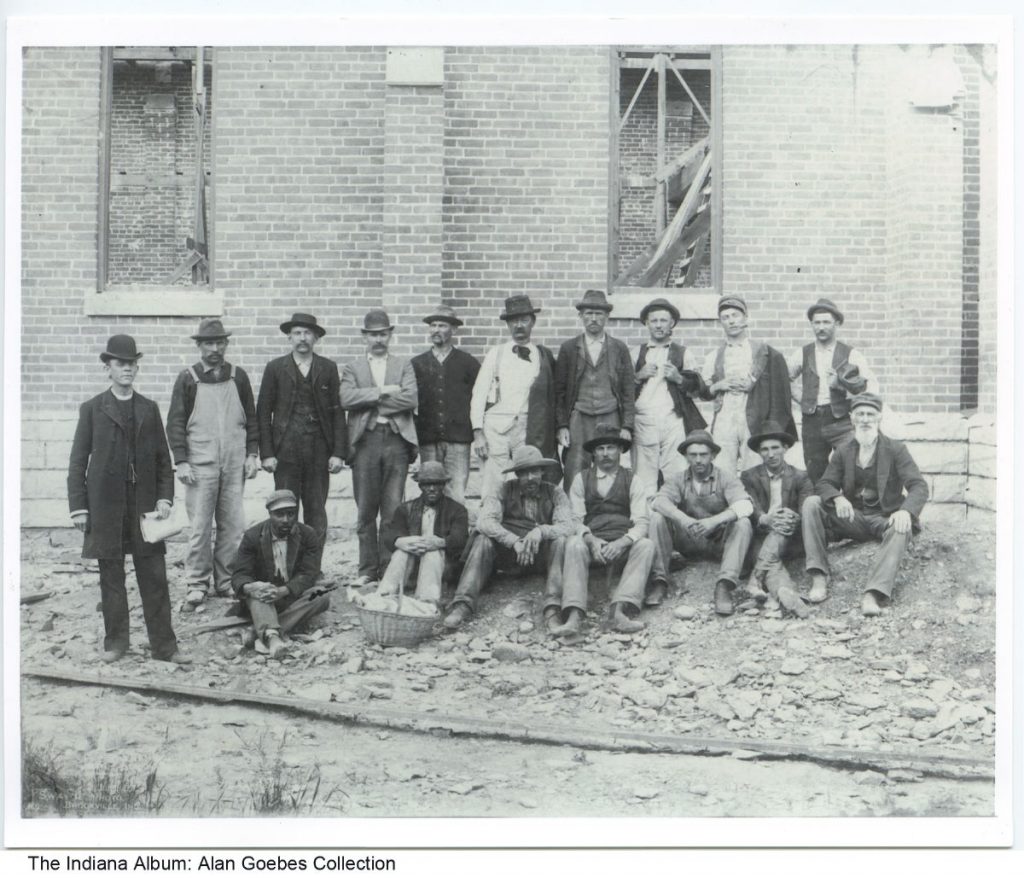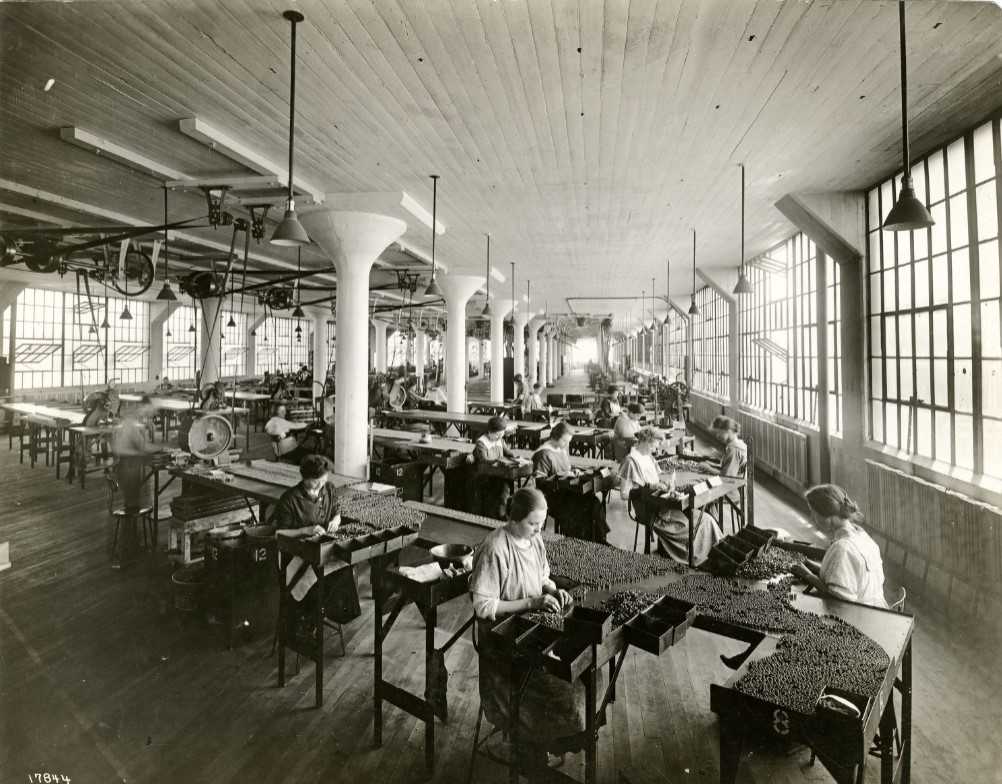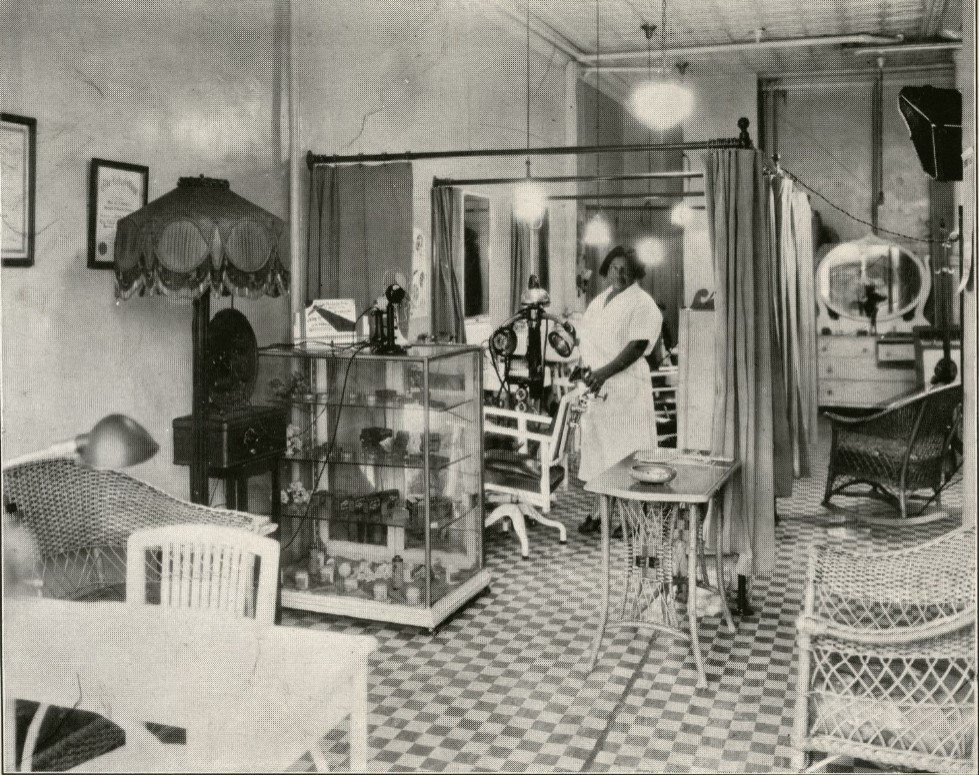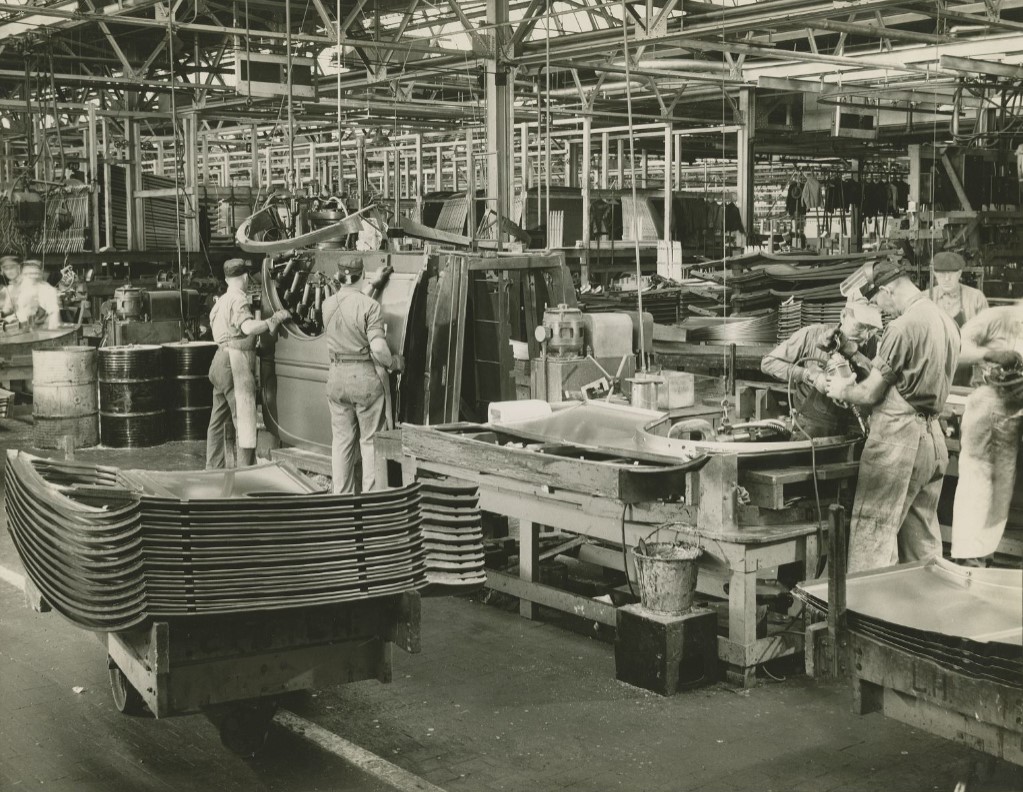Founded in the first two decades of the 19th century, Indianapolis remained a small town until the late 1840s. Business in the state capital was almost entirely local. With 6,000 residents In 1847, Indianapolis acquired the legal status of a city. The completion of the in that year began the development of Indianapolis as the commercial and industrial center of the state. In the 1850s the number of manufacturing industries increased and labor was in great demand; by 1860 the city’s population had tripled to 18,000. The decade of the witnessed greater economic development and population increases. The depression of the 1870s halted growth, but even with economic stagnation the population of Indianapolis in 1880 had reached 75,000. The number of manufacturing establishments grew from 100 in 1860 to nearly 700 in 1880; the number of people employed in these places increased from about 700 in 1860 to 10,000 in 1880. Although the city lagged behind Louisville, Detroit, and Cincinnati in the number of manufacturing establishments and amount of capital invested, it had far outdistanced all other Indiana cities as a manufacturing center and had two and one-half times as many people as Evansville.

The labor force in Indianapolis in this period reflected the regional and increasingly national orientation of its evermore diverse economy. Of the nearly 28,000 men and women employed in the city in 1880, one-quarter (7,000) worked in trade and transportation, one-third (10,000) in professional and personal services, and one-third (10,000) in manufacturing industries. The single most important category for men was manufacturing, an indication of the growing importance of this sector of the economy. The nearly 8,800 men employed in manufacturing worked in a variety of industries, but the two most important were meat packing and the metal trades. By 1870 there were two rolling mills in Indianapolis. Small foundries and machine shops also employed a significant number of people. The largest meatpacking company was , an Irish-owned firm that began operations in Indianapolis in 1864. The first meat-packing firm in the state to use refrigeration to allow slaughtering and packing year-round, Kingan employed 300 to 600 people by the mid-1870s and was one of the largest packinghouses in the world. By 1875 Indianapolis ranked fourth among the cities in the nation as a pork-packing center.
Women comprised 18 percent of the labor force in 1880. Two of every three working women were in the professional and personal services category, the vast majority of these as domestic servants. Another 29 percent of working women were in manufacturing, where they constituted 14 percent of all workers. A few women (197) worked in trade and transportation, but the retail sector was still small-scale and clerk jobs had not yet been feminized.
The vast majority of Indianapolis workers in 1880 (77 percent) had been born in the United States. Eleven percent (3,100) were of origin, and 7 percent (1,900) were . Foreign-born workers tended to cluster in certain occupational categories. Nearly three-fifths of the 1,075 Irish-born workers in 1880 were employed in professional and personal services—no doubt most of these were domestic servants. Many of the 485 Irish immigrants employed in manufacturing likely worked at Kingan and Company. Reputedly, many Irish came to Indianapolis so confident of finding jobs at Kingans that they addressed their trunks to the plant. Lending credence to this claim, an ethnic neighborhood called developed near the plant. The first Germans in Indianapolis were artisans and laborers; by 1880 Germans comprised half of all brewers and maltsters in the city and one-third of all bakers, shoemakers, and cabinetmakers. Forty-six percent of all German-born workers in 1880 labored in manufacturing and mechanical trades. However an equal number of German-born workers in 1880 were employed in tertiary sector jobs; in that year, a large part of the businesses in downtown Indianapolis were owned by German families.
Indianapolis changed dramatically between 1880 and 1920. As its economy grew and diversified, so did its workforce. The size of the workforce increased more than fivefold, from 28,000 in 1880 to 146,000 in 1920. The occupational distribution also changed. Most striking were the dominance of manufacturing, which employed 38 percent of all men in the labor force in 1880 but 50 percent of all men working in 1920, and the growth of retail and office clerk jobs.

Until 1919, when Lake County (with Gary and Hammond) overtook it, held first place in the state in the value of its manufactured products. In 1909, 22 percent of the state’s value of manufactured products came from Indianapolis alone. The city was the leader of the state’s slaughtering and meat-packing industries, its flour-milling industry, and its auto industry. It was a nationally important city, too: in 1919 it ranked fifth among meat-packing cities in the United States; , incorporated in 1881, became one of the three or four largest producers of prescription drugs in the United States. Metal trades continued to be important; in 1890 railroad car construction and repair shops were the fourth largest employer in Indianapolis. In 1920 there were more than 1,000 manufacturing establishments in Indianapolis employing 64,000 people. The places ranged in size from small machine shops employing a handful of people to large plants that employed hundreds of people on several shifts.
The advance of commerce and manufacturing and the growth in population and urban development transformed and increased the number of jobs in the service sector between 1880 and 1920. There were 18,500 clerical workers in Indianapolis in 1920, alone comprising 13 percent of the city’s workforce. The growth of office and retail clerk jobs contributed to the increased number of women in the Indianapolis labor force. Fully half the clerical labor force in 1920 was female. Women also constituted 16 percent of the 22,000 people employed in trade in that year; most of these were retail salesclerks, a new occupation for women that reflected the emergence of department stores like , which opened in 1872 and became one of the largest employers of women in Indianapolis. Another new service occupation that was regarded as a female job was telephone operator: most of the 1,400 women employed in transportation in 1920 were phone operators. The reorganization of the female labor market shifted the occupational distribution of women in Indianapolis. Most notably, the number of women employed in professional and personal service increased in absolute terms between 1880 and 1920. Still, their share of the female labor force dropped dramatically from 67 percent to 38 percent.
The Indianapolis labor force in 1920 remained overwhelmingly white and native born but there were some changes from 1880. The proportion of the foreign-born population in Indianapolis fell from 10 percent in 1900 to 5.4 percent in 1920. The largest share of foreign immigrants (one-third) in 1920 were from Germany; only a small number of immigrants from southern and eastern Europe came to Indianapolis. In contrast, there was a large increase in the Black population of the city. By 1920 there were 35,000 African Americans, comprising 11 percent of the city’s population, one of the highest ratios among major cities in the northern United States. Black workers, who greatly outnumbered those of foreign birth, were restricted to the lowest-paid and least-skilled occupations. More than half of all Black men employed in Indianapolis in 1920 were industrial laborers and one-fifth were domestic and personal service workers. Black women had even fewer job options. In 1920, 83 percent of all employed Black women worked in domestic and personal service; and Black women comprised half of all women employed in this occupational category.

The decades after 1920 witnessed both the maturation and the onset of decline in the industrial economy of Indianapolis. In the 1920s new industries opened shop in the city; , Westinghouse Lamp Works, and a Radio Corporation of American plant (forerunner of the later complex) all opened during that decade. In the Great Depression, the diverse industrial economy of Indianapolis protected it somewhat from the massive unemployment that afflicted cities like Gary, which depended heavily on one or two basic industries. Although Indianapolis led the state in 1929 in the number of companies with more than 500 employees (20), the city’s largest manufacturing firms were small compared to those of other cities; before World War II Indianapolis had only two large manufacturing enterprises, and , each of which employed approximately 3,000 people. The smaller size of firms also moderated somewhat the impact of the depression. But Indianapolis workers did feel the impact of economic collapse. The manufacturing workforce fell by half, from 59,000 in 1920 to 30,000 in 1933. In October 1933, ten thousand families in Marion County were on relief. New Deal work relief projects employed people (mostly white men) primarily in public construction. By the end of the 1930s, the economy had begun to recover, especially as the federal government expanded its national defense program.
World War II brought short-term and long-term changes. Rural out-migration halted during the depression and resumed as people sought higher-paying war jobs and armed services jobs. Between October 1940, and October 1941, alone, 12,600 people moved into Indianapolis, 53 percent of these from elsewhere in Indiana, almost all from rural areas and small towns. The number of people employed in the Indianapolis area increased by half during the war. Indianapolis did very well with federal defense contracts. Factory employment more than doubled rate of increase half again as rapidly as the United States as a whole. Plants employed people around the clock to produce war goods. At its peak in 1943 Allison Division of General Motors, for example, employed 23,019 women and men on three shifts, seven days a week. More firms found the city a good location; Bridgeport Brass, the , the Corporation, RCA, and all expanded or opened plants during World War II and remained after 1945.

Indianapolis continued to grow industrially after World War II. Industrial production soared from $140 million in 1939 to $940 million in 1954. But like other cities in what eventually would be labeled the Rust Belt, Indianapolis began to suffer the ill effects of a series of recessions, decentralization, and industrial decline. Beginning in the 1960s manufacturing plants moved or closed. The closing in 1966 of Hygrade Food Products, the former Kingan and Company factory and still the largest meat-packing plant in Indianapolis with 2,000 employees, helped focus attention on weaknesses in the industrial sector and the need for job retraining and development. Between 1950 and 1970 the absolute number of people employed in manufacturing in the metropolitan area increased from 104,700 to 138,700, but their number relative to total employment dropped from 32 percent to 29 percent. The economic crisis in durable goods manufacturing in the late 1970s-early 1980s exacted its toll on Indianapolis. By 1987, the number of people employed in manufacturing had fallen to 106,000, representing just 17.8 percent of the metropolitan labor force.
The post-World War II expansion of nonmanufacturing industries such as finance, government, retail, and other services compensated for the decline in manufacturing. Between 1950 and 1970 the number of people employed in wholesale and retail jobs rose from 66,900 to 95,000; those in finance increased their numbers from 13,500 to 28,300. The category that experienced the greatest growth relative to total employment between 1950 and 1970 was government, whose share rose from 9.2 percent to 13.9 percent. The expansion of the service sector created a demand for female labor at the same time as families regardless of class came increasingly to depend on more than one adult income. Women comprised a steadily increasing share of the city’s labor force, from 29 percent in 1940 to 44 percent in 1980. They also gained greater access to male-defined occupations. In 1980, for example, there were 5,350 skilled tradeswomen and 337 female lawyers and judges in Indianapolis; each group represented 8 percent and 11.7 percent, respectively, of people so employed. Yet although these proportions were greater than comparable 1940 figures of 3 percent and 1 percent, women’s still small share of such jobs indicated that the ever-increasing number of women in the labor force had taken conventional “women” jobs. In 1980 women comprised 40 percent of those employed in managerial and professional occupations; within this category, there were 7,100 nurses and 12,800 elementary and secondary education teachers. The number of women exceeded the number of men employed in technical, sales, and administrative support occupations in 1980. Indeed, this category employed 48.7 percent of all working women in the city that year. But the two most important jobs held by women in this category—and the two most common jobs for all 235,000 women employed in Indianapolis in 1980—were as sales clerks and secretaries.
Although the occupational distribution of women did not change very much over this century, their marital status did. In 1970, 45.5 percent of all women aged 16 and older were in the Indianapolis labor force. Of these 180,000 women, 59 percent were married; in 1940, 39 percent of all working women were married. Increasing numbers of women with children work. Half of all employed women in the city in 1970 had children under 18.
African Americans experienced some improvement in their labor market status over the 20th century. The demand for labor during World War II offered a measure of upward occupational mobility; some of these gains survived demobilization and reconversion. In 1970, for example, 14.6 percent of all African American men in the city’s workforce were lower-paid manufacturing laborers, compared to a figure of 30 percent in 1940. Moreover, 38 percent of all Black men in the metropolitan labor force in 1970 were craftsmen and operatives, higher-paid and more highly skilled jobs formerly closed to them. For Black women, the picture also has changed. About one-fifth of all Black women in 1970 worked as service and private household workers, compared to four-fifths in 1940. Black women have gained access to clerical and manufacturing jobs; in 1970, 43 percent of all employed Black women in the city held these jobs, which they had been almost completely denied in 1940. Continuity, however, is also apparent. The single most important occupational category for African American women in 1970 still was service; 7,260 women—29 percent of all Black working women—worked in food, health, and cleaning service jobs that year. In contrast, Black women made up a mere 5 percent of all saleswomen in the city in 1970, demonstrating the persistence of racial as well as gender hierarchies in the labor market.
Assessments of the health of Indianapolis’ economy and the prospects of its workforce are generally optimistic in the first decades of the 21st century. The decreasing significance of manufacturing has enabled the city to withstand national economic downturns such as the one in the early 1980s. At the same time, economic development has increased the number of jobs. In 1987 Indianapolis was the 17th fastest growing area for jobs in the United States. The transformation of the urban economic base from manufacturing to service has changed the composition of the city’s workforce in significant and impressive ways. The implications of these changes are not yet fully understood. But if there is cause to doubt the view that a workforce so heavily dependent on service jobs is somehow better off than one with a large share of manufacturing jobs, there also is reason to acknowledge the ability of Indianapolis to avoid the fate of so many other cities undergoing deindustrialization.
*Note: This entry is from the original print edition of the Encyclopedia of Indianapolis (1994). We are currently seeking an individual with knowledge of this topic to update this entry.

Help improve this entry
Contribute information, offer corrections, suggest images.
You can also recommend new entries related to this topic.